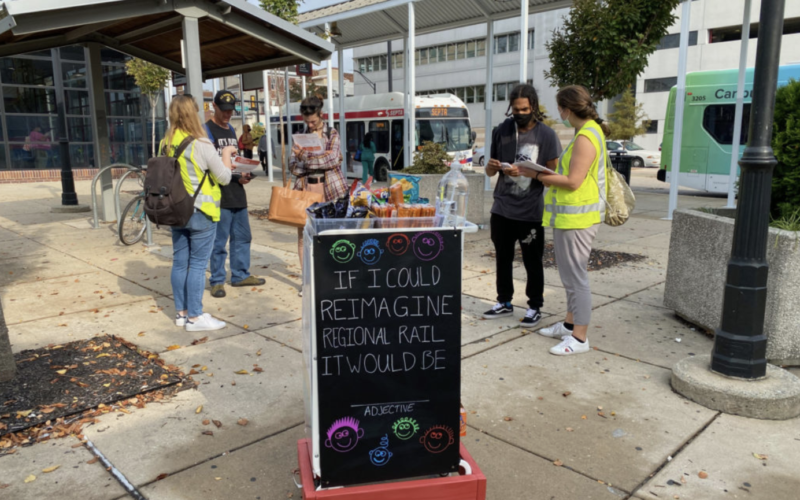
As federal funding from the CARES Act runs out, transit agencies are running up against bleak financial shortfalls. Unless more emergency assistance comes through, agencies will have to cut service to the bone.
These cuts would be far more severe than any following the 2008 recession. That was a bleak period for American transit, but revenue loss due to COVID-19 could make those service reductions feel paltry in comparison.
The impact will be felt deeply by millions of Americans who rely on transit, many of whom are essential workers. TransitCenter spoke with three transit riders in Chicago, New Orleans, and the Bay Area about how the loss of service would affect them.
The Chicago Transit Authority operates the city’s subway and bus service and faces a half-billion dollar deficit in 2020. CTA leadership has already cut service in response to ridership loss, and is not ruling out the possibility of further cuts.
Tom Hagglund, 66, works a collection of part-time jobs throughout the Chicagoland region, including for the University of Chicago Medical School, Rosalind Franklin University, and Divvy bike share. An essential worker, he has relied on transit throughout the pandemic.
On a good day, his commute from Evanston to downtown Chicago can take two hours; on a bad day, three. Most days he boards the CTA Purple Line before dawn, transfers to the Red line, and then boards a bus to arrive at work by 8:00 am. If CTA is forced to cut bus and subway service further, he wonders whether he can continue to rely on it to get to work at all.
Hagglund says service has become less reliable during the pandemic. Several days this month, his 65 Grand Avenue bus never arrived, forcing him to call an Uber to get to work on time.
“Some days I just give up and say, ‘Okay, it will cost me $25 or $30 but at least I’ll get to work on time,’” says Hagglund. “But that eats up a huge percentage of my daily budget.” Haggland says he’ll probably find another way to get around if transit service is reduced further. “But I’m very concerned, especially for people who are sick, or older, or can’t afford to get around the city on anything other than transit.”
In New Orleans, meanwhile, NORTA’s operating budget has been hammered by declining local sales tax revenue, fare revenue, and state subsidies.
Service cuts are already affecting riders like Judy Stevens, 54, a medical imaging specialist who relies on transit to commute from her home in the Michoud neighborhood.
Each day she travels 25 miles to Ochsner Clinic, west of midtown New Orleans. Her commute on the 94 Broad bus and the 39 Tulane bus takes more than an hour on a good day, but lately she has budgeted closer to two.
As service became slower, it became less reliable. Last week Stevens waited for a bus that never came, eventually packing with other riders — many older and some with disabilities — into a crowded bus. The missing bus had been taken out of service after breaking down.
Stevens has no other transportation options. Medical imaging jobs are hard to find near her home in Michoud. She would consider purchasing a bike, but says “not everyone is in the best shape to ride a bike.” She has ruled out carpooling as unsafe — particularly after a colleague’s sister died of the disease. An Uber ride does not fit her daily budget. The cost of a car, insurance, and gasoline is out of the question.
If transit service is not restored, Stevens worries that her community will suffer. “We live in a poor city. If service stops, folks won’t be able to go to the grocery store, see the doctor.”
In the Bay Area, the loss of transit service threatens to upend Stacey Randecker’s family life. Stacey Randecker commutes on Caltrain and her two teenage children ride SFMTA buses to school. Without more emergency aid, both services are at risk.
Stacey’s last job was with a company in Milpitas – a nearly two hour one-way trip on Caltrain and bike from San Francisco to Silicon Valley. After a corporate lay-off, her ability to re-enter the labor force has been threatened—first by the pandemic, now by the potential loss of Caltrain. If Caltrain were to cease operations, Randecker would be unable to accept a job in Silicon Valley without buying a car. She’s unwilling to take that step, both because of the personal expense and the carbon footprint.
With two kids in high school who participate in afterschool activities across the city, the city’s bus system has become a lifeline for her family. “[SFMTA] has been absolutely vital to not owning a car, and for [my kids] to participate in activities that are important to them,” said Randecker Bartlett.
That lifeline is in jeopardy because COVID-19 has devastated SFMTA finances. The agency has eliminated 40 transit lines, to focus available resources on core routes serving essential trips. Facing a $568 million loss over the next four years, SFMTA Director Jeffrey Tumlin has warned that the agency has no path to restore service to those bus lines without new revenue sources.
If given the opportunity, Randecker says she “would tell Speaker Nancy Pelosi that the loss of public transit would be doomsday.”
For Tom Hagglund, Judy Stevens, the Randecker Bartlett family, and millions of other Americans who rely on buses and trains, emergency aid for transit will mean the difference between getting to work, to school, and participating in something resembling normal life — or getting stranded.
 New TransitCenter Report: To Solve Workforce Challenges Once and For All, Transit Agencies Must Put People First
New TransitCenter Report: To Solve Workforce Challenges Once and For All, Transit Agencies Must Put People First
TransitCenter’s new report, “People First” examines the current challenges facing public sector human resources that limit hiring and retention, and outlines potential solutions to rethink this critical agency function.
Read More A Transit Revolution in Philadelphia?
A Transit Revolution in Philadelphia?
The Southeastern Pennsylvania Transportation Authority (SEPTA) has been working throughout the pandemic on several system-wide planning initiatives that have the potential to transform transit service in and around the city of Philadelphia.
Read More